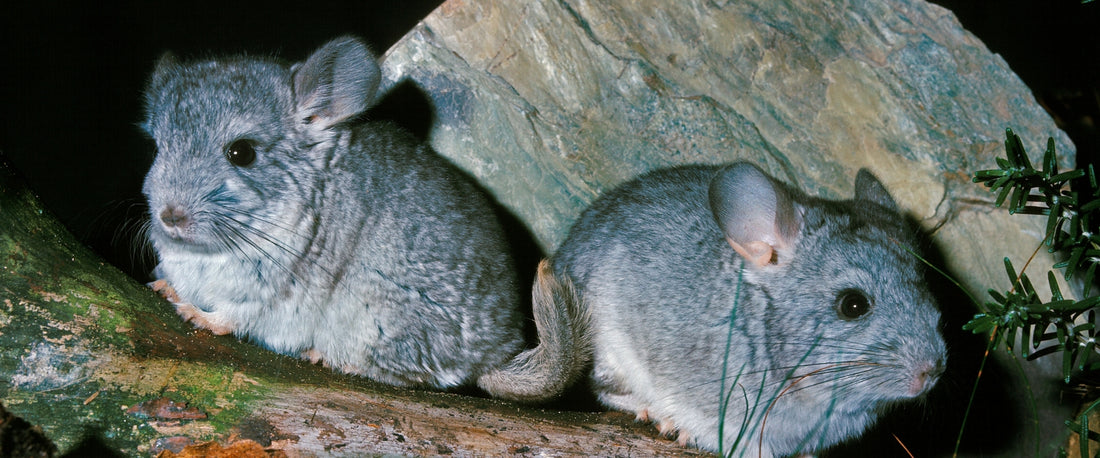
Chinchillas are popular with adults and children alike thanks to their striking appearance. Similar in size to a squirrel, chinchillas are known for their beautiful soft fur, large ears and bushy tails. Chinchillas are a member of the rodent family and can sometimes be found in pet stores alongside rabbits and guinea pigs, making them a tempting alternative.
Before purchasing a chinchilla however, it's wise to research them thoroughly to learn the pros and cons of owning this particular furry little friend and to establish whether they are the right small pet for you.
Read on to discover more about chinchillas.
When did chinchillas first become pets?
Chinchillas have been bred in captivity since the end of the 19th century, but it wasn't until the 1920s that they first became pets.A mining engineer called Mathias F. Chapman was working in Chile in 1918 and purchased a chinchilla from a Chilean Indian. Falling in love with the creature, Chapman decided to capture as many as he could to begin breeding them to sell as pets. Unfortunately, due to excessive trapping, chinchillas were hunted to near extinction, so it took him three years to capture just 11. In fact, most modern pet chinchillas are descended from these animals.
Chapman was granted permission to bring the chinchillas to the United States in 1923 and began breeding them for commercial sale in the years that followed.
Where do chinchillas live?
Chinchillas are naturally quite fragile creatures, so they need to be housed away from extreme heat or cold. Ideally, they should be kept indoors in a large enclosure rather than a cage, or even their own room in your house. Their enclosure should be kept in a draught-free environment away from direct sunlight. Chinchillas cannot sweat, so exposure to direct sunlight can cause dangerous sunstroke.

The recommended minimum size enclosure for a chinchilla is 2 metres high, 2 metres wide and 1 meter deep and should have plenty of room for them to run around, with shelves at different levels to allow them to jump and play.
Chinchillas are most active at dusk and dawn, so require an enclosed bed to sleep in during the day. Wooden boxes are ideal as a bed but need to be large enough for all animals in the cage to sleep together if they choose.

How high can they jump?
Chinchillas should be let out of their cages daily for exercise but before you release them, it’s a good idea to ensure you remove any potential hazards and secure the room to prevent escape. Chinchillas can actually jump over 6 feet high and have sharp teeth that they like to explore with.
Masters of escape, they also have a defence mechanism called a fur slip that they can use to evade capture. Handle them incorrectly and you'll be left with a tuft of fur while your little friend bounces away!
How long do chinchillas live?
With the correct care, chinchillas can live for as many as 20 years. The average lifespan for a pet chinchilla is 12-15 years, so you should make sure you can commit to owning and caring for one of these furry friends long-term.

Do chinchillas need company?
In the wild, chinchillas live in herds of more than 100 animals. In captivity, a single chinchilla is likely to be unhappy, so it's best to have at least a pair. Unless you are looking to breed them, it's naturally best to keep animals of the same sex.Whilst they do like to live with other chinchillas, their home should be large enough to allow them to run around and get away from each other if they want to, and ideally have some safe exercise area outside of their cage or enclosure for them to use every day.

How do chinchillas communicate?
Chinchillas are naturally cautious and perceive most actions as a potential danger. To communicate with your chinchilla and develop a relationship, it’s a good idea to maintain a quiet, nonthreatening tone at all times. Speaking softly, not making sudden movements, and lowering yourself to their level all encourage your furry friend to come to you.
Gently stroking them under the chin and encouraging them to take treats are great ways to build your relationship.
What do chinchillas eat?
Chinchillas are herbivores and live on a diet that mainly consists of hay and grass. Hay needs to be high-quality feeding hay that contains beneficial fibre, such as Timothy Feeding Hay. Feeding hay is different to bedding hay. Bedding hay is of lower quality and doesn't have the same nutritional values.
Chinchillas can also benefit from a small portion of daily treats such as chinchilla nuggets and certain fruits and vegetables, including apple, carrot, sweet potato, and raisins. To help with incorporating these into your chinchilla's daily diet, at Newhay we have incorporated some of these tasty treats into our nutritious feeding hay, so check out our Carrot and Apple variety for the perfect balanced feeding hay for your furry friends.
In addition, fresh water should be available at all times. Read our Chinchilla feeding guide for further tips on how to provide a nutritious and healthy diet and look after the wellbeing of your Chinchilla.

How to groom a chinchilla
Chinchillas don't usually require grooming as they self-clean on a regular basis. They do require a chinchilla dust bath that they can use to clean themselves. This special dust sticks to their fur, absorbing oil and dirt before falling off.
Dust should be changed once a week and should be deep enough for them to roll around without injury.
If you do need to groom your chinchilla, be sure to handle them gently and support their whole body. You should never grab him or pick him up by the tail, as this can result in serious injury.

Do chinchillas make good pets?
As with any animal, there are pros and cons to owning a chinchilla. If cared for correctly, chinchillas can provide many years of love and joy to their owners. They are quiet, clean, and attractive animals that require little attention.
Due to their timid personalities and delicate anatomy, chinchillas are best suited to adult owners and don't tend to make a good pet for children. Whereas rabbits and guinea pigs can be happy being handled regularly, chinchillas generally don't like being handled and it can be dangerous to the animal if they are handled incorrectly.
If you would like to learn more about Chinchillas and which other small herbivores make good pets, check out our article Choosing the right pet for you.

